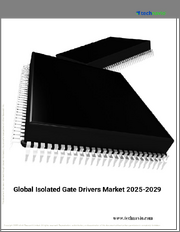
|
시장보고서
상품코드
1623710
세계의 디스플레이 컨트롤러 시장 - 규모, 점유율, 성장 분석 : 유형별, 용도별, 기술별, 최종 사용자별, 지역별 산업 예측(2025-2032년)Display Controller Market Size, Share, Growth Analysis, By Type (Digital Display Controller, Smart Display Controller), By Application (Consumer Electronics, Medical Equipment), By Technology, By End-User, By Region - Industry Forecast 2025-2032 |
||||||
디스플레이 컨트롤러 세계 시장 규모는 2023년에 301억 6,000만 달러로 평가되었고, 2024년 330억 9,000만 달러에서 2032년에는 693억 9,000만 달러로 성장해 예측 기간(2025-2032년) CAGR은 9.7%로 성장할 전망입니다.
디스플레이 컨트롤러로도 알려진 그래픽 카드 세계 시장은 의료를 비롯한 다양한 산업에서 시각 데이터 표현에 필수적인 역할을 하기 때문에 상당한 성장이 예상되고 있습니다. 디스플레이 및 화상 회의 도구에 대한 수요가 증가함에 따라 시장 동향을 형성하고 있습니다. 특히 고객의 경험을 제공함으로써 마케팅 효과를 높이고 브랜드 충성도에 직접 기여하기 때문에 특히 중요합니다. 최종 사용자에게 매우 중요하며 다양한 응용 분야에서 디스플레이 컨트롤러의 추가 채택을 촉진합니다.
목차
소개
- 조사의 목적
- 조사 범위
- 정의
조사 방법
- 정보 조달
- 2차 데이터와 1차 데이터의 방법
- 시장 규모 예측
- 시장의 전제조건과 제한
주요 요약
- 세계 시장 전망
- 공급과 수요 동향 분석
- 부문별 기회 분석
시장 역학과 전망
- 시장 개요
- 시장 규모
- 시장 역학
- 성장 촉진요인과 기회
- 억제요인과 과제
- Porter's Five Forces 분석
주요 시장 인사이트
- 중요성공요인
- 경쟁도
- 주요 투자 기회
- 시장 생태계
- 시장의 매력 지수(2024년)
- PESTEL 분석
- 거시경제지표
- 밸류체인 분석
- 가격 분석
- 사례 연구
- 기술의 진보
- 규제 상황
- 고객 및 구매 기준 분석
- 원료 분석
- 특허 분석
디스플레이 컨트롤러 시장 규모 : 유형별&CAGR(2025-2032년)
- 시장 개요
- 디지털 디스플레이 컨트롤러
- 스마트 디스플레이 컨트롤러
- 터치스크린 컨트롤러
- 멀티 디스플레이 컨트롤러
- 기타
디스플레이 컨트롤러 시장 규모 : 용도별 &CAGR(2025-2032년)
- 시장 개요
- 소비자용 전자 기기
- 스마트폰
- 태블릿
- TV
- 의료기기
- 오피스 오토메이션
- 자동차
- 인포테인먼트 시스템
- 계기 클러스터
- 산업용 제어
- 기타
디스플레이 컨트롤러 시장 규모 : 기술별&CAGR(2025-2032년)
- 시장 개요
- LCD 컨트롤러
- LED 컨트롤러
- OLED 컨트롤러
- TFT 컨트롤러
디스플레이 컨트롤러 시장 규모 : 최종 사용자별 &CAGR(2025-2032년)
- 시장 개요
- 주택용
- 상업용
- 산업용
디스플레이 컨트롤러 시장 규모&CAGR(2025-2032년)
- 북미
- 미국
- 캐나다
- 유럽
- 독일
- 스페인
- 프랑스
- 영국
- 이탈리아
- 기타 유럽
- 아시아태평양
- 중국
- 인도
- 일본
- 한국
- 기타 아시아태평양
- 라틴아메리카
- 브라질
- 기타 라틴아메리카
- 중동 및 아프리카
- GCC 국가
- 남아프리카
- 기타 중동 및 아프리카
경쟁 정보
- 상위 5개사 비교
- 주요 기업의 시장 포지셔닝(2024년)
- 주요 시장 기업이 채용한 전략
- 시장의 최근 동향
- 기업의 시장 점유율 분석(2024년)
- 주요 기업의 기업 프로파일
- 제품 포트폴리오 분석
- 부문별 점유율 분석
- 수익의 전년대비 비교(2022-2024년)
주요 기업 프로파일
- Samsung Electronics Co., Ltd.(한국)
- LG Display Co., Ltd.(한국)
- Texas Instruments, Inc.(미국)
- Toshiba Corporation(일본)
- Fujitsu Ltd.(일본)
- Siemens AG(독일)
- STMicroelectronics NV(스위스)
- NXP Semiconductors NV(네덜란드)
- Synaptics Incorporated(미국)
- Himax Technologies, Inc.(대만)
- MediaTek Inc.(대만)
- National Instruments Corporation(미국)
- Silicon Laboratories Inc.(미국)
- Panasonic Corporation(일본)
- Analog Devices, Inc.(미국)
- Parade Technologies Ltd.(대만)
- Innolux Corporation(대만)
- ON Semiconductor Corporation(미국)
- Renesas Electronics Corporation(일본)
결론과 권장사항
JHS 25.01.16Global Display Controller Market size was valued at USD 30.16 billion in 2023 and is poised to grow from USD 33.09 billion in 2024 to USD 69.39 billion by 2032, growing at a CAGR of 9.7% during the forecast period (2025-2032).
The global market for graphics cards, also known as display controllers, is expected to grow significantly due to their essential role in visual data representation across various industries, including healthcare. The increasing demand for high-quality displays and video conferencing tools, alongside the rise of interactive retail displays, is shaping market trends. Retail displays are especially important as they enhance marketing effectiveness by delivering informative and personalized customer experiences, directly contributing to brand loyalty. As technology advances and consumer expectations evolve, the ability to present detailed visual content quickly and accurately will be crucial for end-users, driving further adoption of display controllers in diverse applications.
Top-down and bottom-up approaches were used to estimate and validate the size of the Global Display Controller market and to estimate the size of various other dependent submarkets. The research methodology used to estimate the market size includes the following details: The key players in the market were identified through secondary research, and their market shares in the respective regions were determined through primary and secondary research. This entire procedure includes the study of the annual and financial reports of the top market players and extensive interviews for key insights from industry leaders such as CEOs, VPs, directors, and marketing executives. All percentage shares split, and breakdowns were determined using secondary sources and verified through Primary sources. All possible parameters that affect the markets covered in this research study have been accounted for, viewed in extensive detail, verified through primary research, and analyzed to get the final quantitative and qualitative data.
Global Display Controller Market Segmental Analysis
Global Display Controller Market is segmented by Type, Application, Technology, End-User and region. Based on Type, the market is segmented into Digital Display Controller, Smart Display Controller, Touch Screen Controller, Multi-Display Controller and Others. Based on Application, the market is segmented into Consumer Electronics, Medical Equipment, Office Automation, Automotive, Industrial Control and Others. Based on Technology, the market is segmented into LCD Controllers, LED Controllers, OLED Controllers and TFT Controllers. Based on End-User, the market is segmented into Residential, Commercial and Industrial. Based on region, the market is segmented into North America, Europe, Asia Pacific, Latin America and Middle East & Africa.
Driver of the Global Display Controller Market
The Global Display Controller market is significantly driven by the growing utilization of interactive displays within the retail sector, aimed at enhancing customer engagement. This trend is coupled with a rising demand for advanced display controllers in teleconferencing setups and an increase in mobile computing devices that require sophisticated display and controller technologies. Additionally, the evolution of display controllers from basic components to comprehensive system controllers is fueling market growth. Expanding applications in the automotive industry and an increasing prevalence of displays at trade shows and events are also creating substantial opportunities, further propelling the expansion of the display controllers market in the upcoming period.
Restraints in the Global Display Controller Market
One significant restraint impacting the global display controller market is the shortage of skilled labor. The absence of adequately trained professionals capable of developing sophisticated software programs and managing intricate manufacturing processes poses a considerable challenge for growth within this sector. This skill gap may hinder the ability to innovate and implement various operating systems, resulting in delays and increased complexity that could stifle overall market expansion. Consequently, the unavailability of a proficient workforce to tackle these technical demands could restrict advancements and responsiveness to emerging trends, ultimately limiting the potential for progress and competitiveness in the display controller industry during the projected period.
Market Trends of the Global Display Controller Market
The global Display Controller market is poised for substantial growth, driven by the escalating demand for advanced mobile computing devices that feature high-quality display and controller technologies, a trend spurred by ongoing digitalization. Market segmentation by video interfaces includes video shifters, video interface controllers, and video co-processors, highlighting the diversity of applications. Additionally, the rise of interactive displays in the retail sector to enhance customer engagement is prompting manufacturers to ramp up production. This convergence of technological advancements and growing sector demand is expected to propel the Display Controller market forward significantly in the upcoming years.
Table of Contents
Introduction
- Objectives of the Study
- Scope of the Report
- Definitions
Research Methodology
- Information Procurement
- Secondary & Primary Data Methods
- Market Size Estimation
- Market Assumptions & Limitations
Executive Summary
- Global Market Outlook
- Supply & Demand Trend Analysis
- Segmental Opportunity Analysis
Market Dynamics & Outlook
- Market Overview
- Market Size
- Market Dynamics
- Drivers & Opportunities
- Restraints & Challenges
- Porters Analysis
- Competitive rivalry
- Threat of substitute
- Bargaining power of buyers
- Threat of new entrants
- Bargaining power of suppliers
Key Market Insights
- Key Success Factors
- Degree of Competition
- Top Investment Pockets
- Market Ecosystem
- Market Attractiveness Index, 2024
- PESTEL Analysis
- Macro-Economic Indicators
- Value Chain Analysis
- Pricing Analysis
- Case Studies
- Technology Advancement
- Regulatory Landscape
- Customer & Buying Criteria Analysis
- Raw Material Analysis
- Patent Analysis
Global Display Controller Market Size by Type & CAGR (2025-2032)
- Market Overview
- Digital Display Controller
- Smart Display Controller
- Touch Screen Controller
- Multi-Display Controller
- Others
Global Display Controller Market Size by Application & CAGR (2025-2032)
- Market Overview
- Consumer Electronics
- Smartphones
- Tablets
- Televisions
- Medical Equipment
- Office Automation
- Automotive
- Infotainment Systems
- Instrument Clusters
- Industrial Control
- Others
Global Display Controller Market Size by Technology & CAGR (2025-2032)
- Market Overview
- LCD Controllers
- LED Controllers
- OLED Controllers
- TFT Controllers
Global Display Controller Market Size by End-User & CAGR (2025-2032)
- Market Overview
- Residential
- Commercial
- Industrial
Global Display Controller Market Size & CAGR (2025-2032)
- North America (Type, Application, Technology, End-User)
- US
- Canada
- Europe (Type, Application, Technology, End-User)
- Germany
- Spain
- France
- UK
- Italy
- Rest of Europe
- Asia Pacific (Type, Application, Technology, End-User)
- China
- India
- Japan
- South Korea
- Rest of Asia-Pacific
- Latin America (Type, Application, Technology, End-User)
- Brazil
- Rest of Latin America
- Middle East & Africa (Type, Application, Technology, End-User)
- GCC Countries
- South Africa
- Rest of Middle East & Africa
Competitive Intelligence
- Top 5 Player Comparison
- Market Positioning of Key Players, 2024
- Strategies Adopted by Key Market Players
- Recent Developments in the Market
- Company Market Share Analysis, 2024
- Company Profiles of All Key Players
- Company Details
- Product Portfolio Analysis
- Company's Segmental Share Analysis
- Revenue Y-O-Y Comparison (2022-2024)
Key Company Profiles
- Samsung Electronics Co., Ltd. (South Korea)
- Company Overview
- Business Segment Overview
- Financial Updates
- Key Developments
- LG Display Co., Ltd. (South Korea)
- Company Overview
- Business Segment Overview
- Financial Updates
- Key Developments
- Texas Instruments, Inc. (USA)
- Company Overview
- Business Segment Overview
- Financial Updates
- Key Developments
- Toshiba Corporation (Japan)
- Company Overview
- Business Segment Overview
- Financial Updates
- Key Developments
- Fujitsu Ltd. (Japan)
- Company Overview
- Business Segment Overview
- Financial Updates
- Key Developments
- Siemens AG (Germany)
- Company Overview
- Business Segment Overview
- Financial Updates
- Key Developments
- STMicroelectronics N.V. (Switzerland)
- Company Overview
- Business Segment Overview
- Financial Updates
- Key Developments
- NXP Semiconductors N.V. (Netherlands)
- Company Overview
- Business Segment Overview
- Financial Updates
- Key Developments
- Synaptics Incorporated (USA)
- Company Overview
- Business Segment Overview
- Financial Updates
- Key Developments
- Himax Technologies, Inc. (Taiwan)
- Company Overview
- Business Segment Overview
- Financial Updates
- Key Developments
- MediaTek Inc. (Taiwan)
- Company Overview
- Business Segment Overview
- Financial Updates
- Key Developments
- National Instruments Corporation (USA)
- Company Overview
- Business Segment Overview
- Financial Updates
- Key Developments
- Silicon Laboratories Inc. (USA)
- Company Overview
- Business Segment Overview
- Financial Updates
- Key Developments
- Panasonic Corporation (Japan)
- Company Overview
- Business Segment Overview
- Financial Updates
- Key Developments
- Analog Devices, Inc. (USA)
- Company Overview
- Business Segment Overview
- Financial Updates
- Key Developments
- Parade Technologies Ltd. (Taiwan)
- Company Overview
- Business Segment Overview
- Financial Updates
- Key Developments
- Innolux Corporation (Taiwan)
- Company Overview
- Business Segment Overview
- Financial Updates
- Key Developments
- ON Semiconductor Corporation (USA)
- Company Overview
- Business Segment Overview
- Financial Updates
- Key Developments
- Renesas Electronics Corporation (Japan)
- Company Overview
- Business Segment Overview
- Financial Updates
- Key Developments



















